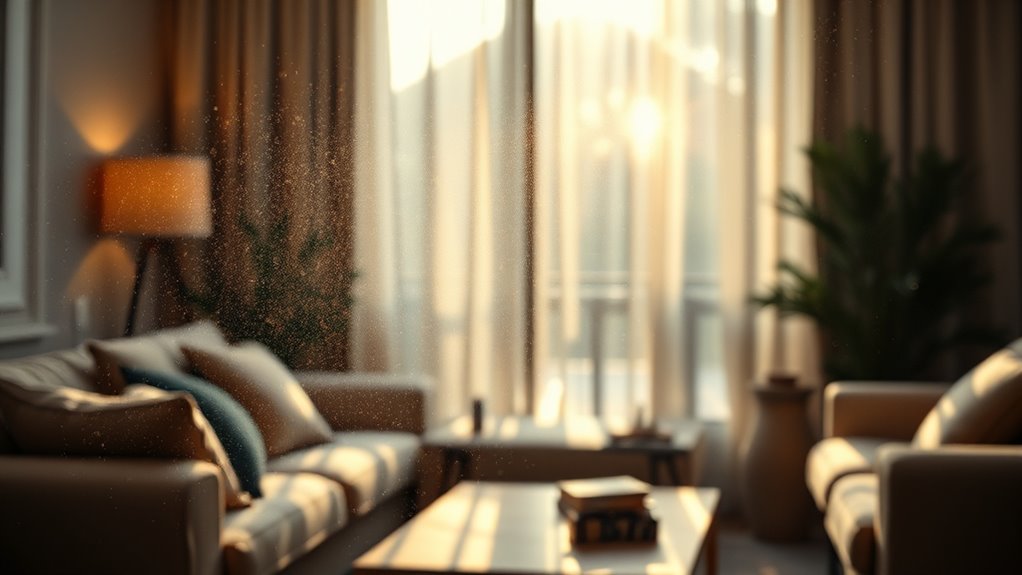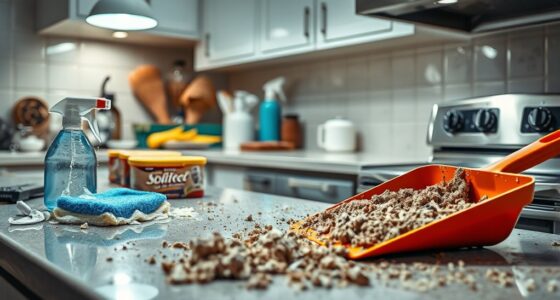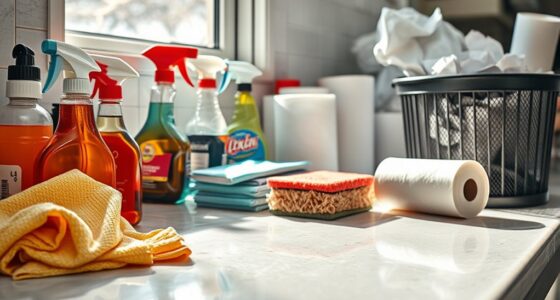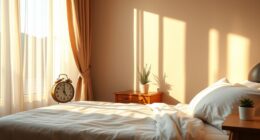Indoor dust is often the hidden cause of constant sneezing and allergy symptoms, creating a relentless dust storm inside your home. Dust includes pollen, pet dander, mold spores, and dirt that settle on surfaces or stay airborne, irritating your respiratory system. Many overlook it as the culprit. Using an air purifier can help reduce airborne irritants and improve your air quality. Keep going to discover how you can better combat this indoor annoyance and breathe easier.
Key Takeaways
- Indoor dust storms are caused by accumulated dust particles like pollen, pet dander, mold spores, and dirt circulating indoors.
- Persistent sneezing and allergy symptoms often result from ongoing exposure to indoor allergens.
- Air purifiers with HEPA filters effectively remove airborne irritants, reducing allergy symptoms and improving air quality.
- Proper maintenance and placement of air purifiers enhance their ability to trap dust and allergens efficiently.
- Regular cleaning and filtration help prevent indoor dust buildup, minimizing the risk of indoor dust storms and related health issues.
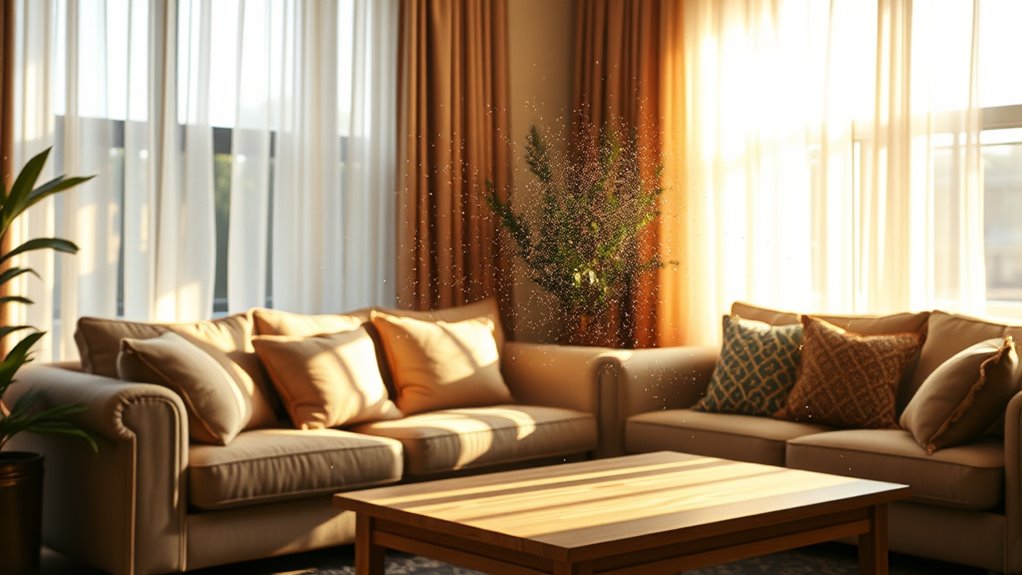
Dust storms aren’t limited to the outdoors; they can also invade your home, turning your indoor space into a whirlwind of dirt and debris. You might notice persistent sneezing, itchy eyes, or congestion even when you’re inside, and it’s easy to blame seasonal allergies or colds. But what’s often overlooked is that dust particles can accumulate inside your home just as fiercely as they do outside. These tiny particles, including pollen, pet dander, mold spores, and dirt, can settle on surfaces or float in the air, triggering allergy symptoms and making your environment uncomfortable.
One effective way to combat this invisible menace is by using an air purifier. Air purifier benefits extend beyond just freshening the air; they actively trap and remove airborne allergens and pollutants. This means fewer irritants circulating in your living space, reducing the likelihood of allergy symptoms. Whether you suffer from hay fever or are just sensitive to dust, an air purifier can considerably improve your indoor air quality. When you invest in a quality unit with HEPA filters, you’re targeting the smallest particles—those that often escape your regular cleaning routines. This helps create a cleaner environment where allergens are less likely to settle on your furniture or bedding, making your home a safer haven for allergy prevention.
Using an air purifier with HEPA filters reduces airborne allergens and creates a healthier indoor environment.
Using an air purifier regularly can be especially helpful if you have pets, as pet dander is notorious for lingering in the air and triggering allergies. It also benefits households with smokers or those living in areas with high pollution levels. By continuously filtering the air, these devices prevent dust and other irritants from reaching your respiratory system. The result? You breathe easier, and your sneezing fits decrease in frequency and intensity.
Beyond allergy prevention, air purifiers contribute to overall indoor air quality, reducing dust buildup, mold spores, and even bacteria. This is particularly important if you or your family members have respiratory issues or asthma. Maintaining a cleaner indoor environment becomes easier when you rely on an air purifier, which works silently in the background to keep harmful particles at bay. Regularly changing filters and ensuring proper placement of the device maximizes its benefits, making it an essential tool in your fight against indoor dust storms. Incorporating air purification technology into your routine can significantly enhance your home’s air quality and comfort.
Frequently Asked Questions
Can Indoor Dust Storms Occur Without Visible Dust Particles?
Yes, indoor dust storms can happen without visible dust particles. You might experience this because dust accumulation often includes hidden allergens like mold spores, pet dander, or pollen that aren’t visible to the naked eye. These tiny particles can become airborne with everyday activities, causing sneezing and allergies. So, even if you don’t see dust, it’s likely there, hidden in your home’s air, triggering your symptoms.
Do Certain Houseplants Help Reduce Indoor Dust?
Did you know certain houseplants can improve indoor air quality? They offer great houseplant benefits, including natural dust filtration, which helps reduce airborne dust particles. Some plants like peace lilies and spider plants are especially effective at trapping dust and pollutants. By adding these to your home, you can create a healthier environment, lessen sneezing triggers, and enjoy cleaner, fresher air every day.
How Often Should I Replace Air Filters for Allergy Relief?
You should replace your air filter regularly to maintain allergy relief. Typically, an air filter lifespan is about 30 to 90 days, depending on your home environment and filter type. Using allergy-friendly filters can improve air quality and reduce sneezing. Check your filters monthly and replace them when they look dirty or after the recommended timeframe. This keeps indoor air fresh and minimizes airborne allergens effectively.
Are Air Purifiers Effective Against Indoor Dust Storms?
Think of an air purifier as a shield against indoor dust storms, which are often caused by triggers like dust buildup or allergens. While many air purifier myths exist, they can be effective if chosen correctly. They help capture airborne particles and reduce dust storm causes indoors. However, they aren’t magic; regular cleaning and proper filter maintenance are essential. Used correctly, an air purifier can markedly improve your indoor air quality.
Can Cleaning Products Worsen Indoor Dust Problems?
You might wonder if cleaning products worsen indoor dust problems. They can, because some contain chemicals that irritate your air, increasing airborne allergens like dust mite particles. When you use harsh cleaners, you may stir up dust and allergens, making sneezing worse. To improve indoor air quality, choose gentle, fragrance-free cleaners, and regularly vacuum with a HEPA filter to remove dust and dust mite debris effectively.
Conclusion
So, next time you’re battling relentless sneezing, don’t just blame the usual suspects. Your home might be hosting a hidden dust storm, more powerful than a hurricane, quietly wreaking havoc on your nose. Take action—clean regularly, improve ventilation, and consider air purifiers. Don’t let invisible dust monsters rule your life; reclaim your space and breathe freely again. Because surviving a dust storm indoors shouldn’t feel like fighting a never-ending battle with nature itself.
